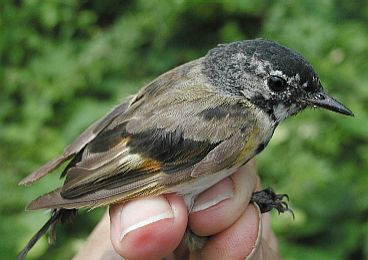PICTORIAL HIGHLIGHTS, WEEK
OF 7/2/01-7/7/01
Many forest-nesting birds select dense shrubby
habitats for providing post-fledging care and while undergoing their annual
molt. Consequently, at this time of year we often catch large numbers
of woodland breeding songbirds (both adults and young-of-the-year, i.e.,
HYs), like Wood Thrush, Scarlet
Tanager, Rose-breasted
Grosbeak, Black-and-white
Warbler and American
Redstart when they move out of the surrounding forest into the adjacent, well-protected,
bug- and berry-rich, shrub-scrub habitats where we have our nets.
The photo is of a second-year male AMRE
molting from its dull female-like first alternate, i.e., breeding, plumage
to the bright black and orange definitive basic plumage of an adult male
(a unique reversal of the usual "confusing fall warbler" scenario!).
Even species like Veery
and Canada Warbler
that nest at higher elevations well away from our banding area apparently
seek out dense shrubby habitats at lower elevations, where they can find
abundant cover and food, shortly after their young have fledged.
when they move out of the surrounding forest into the adjacent, well-protected,
bug- and berry-rich, shrub-scrub habitats where we have our nets.
The photo is of a second-year male AMRE
molting from its dull female-like first alternate, i.e., breeding, plumage
to the bright black and orange definitive basic plumage of an adult male
(a unique reversal of the usual "confusing fall warbler" scenario!).
Even species like Veery
and Canada Warbler
that nest at higher elevations well away from our banding area apparently
seek out dense shrubby habitats at lower elevations, where they can find
abundant cover and food, shortly after their young have fledged.
Also, it is not uncommon at this time of year
for species that nest no closer than 100 km away from Powdermill (e.g.,
Swainson's Thrush, Tennessee
Warbler) to be caught still showing physical
signs of recent breeding activity (old brood patches or cloacal protuberances)
and, either not having yet begun their molt, or having only just begun
it. Such birds, possibly failed breeders, apparently undertake signficant
southward flights away from their breeding grounds before their prebasic
molt overtakes them. So, look for a SWTH,
TEWA
or similar northern-nesting species to show up on this list within the
next few weeks. Did someone say "fall migration?!"
<BACK
 when they move out of the surrounding forest into the adjacent, well-protected,
bug- and berry-rich, shrub-scrub habitats where we have our nets.
The photo is of a second-year male AMRE
molting from its dull female-like first alternate, i.e., breeding, plumage
to the bright black and orange definitive basic plumage of an adult male
(a unique reversal of the usual "confusing fall warbler" scenario!).
Even species like Veery
and Canada Warbler
that nest at higher elevations well away from our banding area apparently
seek out dense shrubby habitats at lower elevations, where they can find
abundant cover and food, shortly after their young have fledged.
when they move out of the surrounding forest into the adjacent, well-protected,
bug- and berry-rich, shrub-scrub habitats where we have our nets.
The photo is of a second-year male AMRE
molting from its dull female-like first alternate, i.e., breeding, plumage
to the bright black and orange definitive basic plumage of an adult male
(a unique reversal of the usual "confusing fall warbler" scenario!).
Even species like Veery
and Canada Warbler
that nest at higher elevations well away from our banding area apparently
seek out dense shrubby habitats at lower elevations, where they can find
abundant cover and food, shortly after their young have fledged.